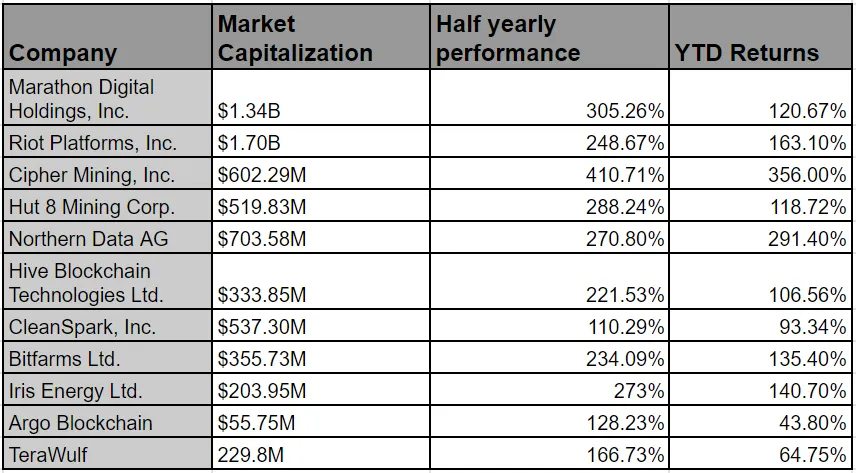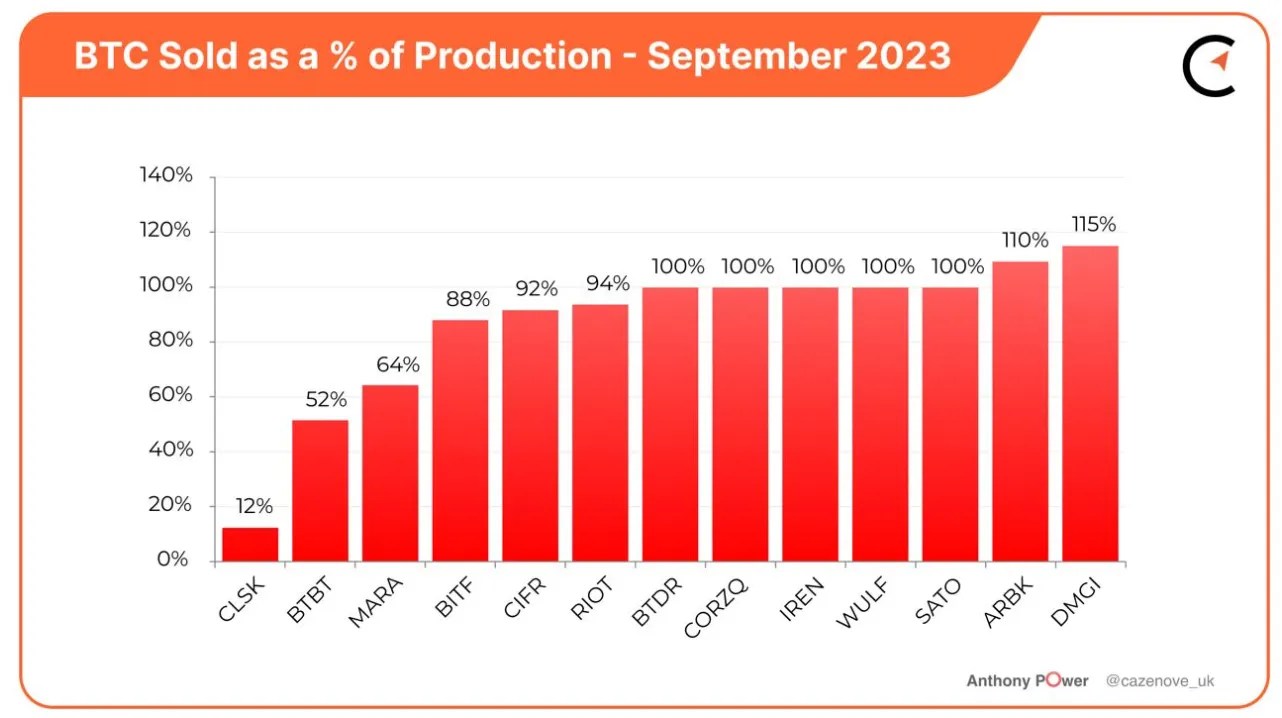The year-to-date returns of all mining stocks, except for two, have far outpaced Bitcoin's rise of 84.61%, per CoinGecko data.
The two underperforming mining firms? Argo Blockchain and TeraWulf.
Still, the average return of the top eleven public mining companies this year is more than double that of Bitcoin, standing at 148.59%.
Marathon Digital Holdings and Cipher Mining lead the gains with 120.67% and 356.00% year-to-date gains, respectively. The mining stocks have exhibited a higher beta over Bitcoin.
A higher beta signifies increased volatility and a tendency to move with a greater magnitude in the same direction as the market or benchmark index–in this case, Bitcoin.
For example, during the first half of what was a bullish start to the year for BTC, mining stocks frequently outperformed Bitcoin during positive rallies.
Similarly, during Bitcoin’s downfall in the third quarter, the majority of the mining stocks retraced by an average of 50% compared to Bitcoin’s price drop of around 10%.

Bitcoin miners ride the bear
Besides enjoying higher beta over Bitcoin’s price, mining stocks have also benefited from the increase in Bitcoin mining revenue due to the increased usage of Ordinals.
Ordinals are digital files stored on the smallest Bitcoin unit, known as a satoshi, or simply “sat.” They’ve ushered in something of an NFT market on the Bitcoin blockchain.
Rich Rines, an initial contributor to Core DAO, told Decrypt that after facing significant challenges in 2022, the mining “companies are taking advantage of renewed Bitcoin excitement and market performance.”
He added that new use cases such as Ordinals inscriptions and BRC-20 tokens are increasing the profitability and demand for mining.
Anthony Power, mining analyst at mining firm Compass Mining, wrote in a recent report that public miners saw “increased production and greater mining revenues” in September thanks to an increase in Bitcoin’s price and a temporary negative adjustment in mining difficulty.
Mining difficulty is an automatic parameter inherent in Bitcoin's design and a factor of the network’s total mining power, represented by hashrate. The difficulty increases when blocks are being mined too quickly–or hashrate increases–and decreases when it takes longer than 10 minutes to mine a block.
Since the start of the year, the newtork's hashrate, and consequently its difficulty, has steadily risen despite the ongoing bear market. In fact, the mining difficulty made a new all-time high yesterday.

Charles Edwards, the founder of Captriole Investments recently tweeted that the recent rise in hash rate “is a step change in mining industrialization” suggesting that “energy companies and governments are here.”
Mining firms prepare for halving
Public miners have also been selling a significant portion of their newly produced Bitcoin, Power’s report shows.
He wrote that “miners are currently using a strategy of selling a large proportion of their mined Bitcoin to pay for capital growth and operational costs.”

Mining firms are now turning their attention to the halving event slated for next year, buying up additional machines and increasing their computational power. Per CoinWarz, the halving is expected to occur at the end of April.
The halving is a periodic event that reduces the reward miners receive for verifying transactions by 50% every four years. For miners, this means that they’ll need to expand their operations in order to continue hitting their pre-halving revenue goals.
Core DAO’s Rines told Decrypt that miners can likely benefit from the initial excitement around halving “as a critical milestone.” However, eventually these “must also face the reality that their rewards will be abruptly cut in half and their business models will be tested.”
He added that the performance of mining companies will depend on Bitcoin’s price leading up to the halving and preparation of individual miners “from a financial and operational perspective.”
Popular crypto trader, Oliver L. Velez, on the other hand, is bearish on mining stocks leading up to the halving and expects “underperformance to continue for several months after” due to the reduction in rewards, he told Decrypt.
Velez added that if Bitcoin doesn’t hit $65,000 before the halving, “less efficient miners” might capitulate or risk being “taken over by the more efficient ones.”
Edited by Liam Kelly.

